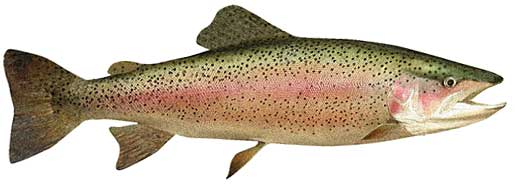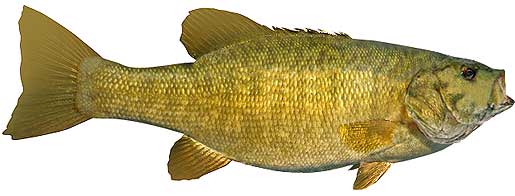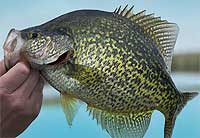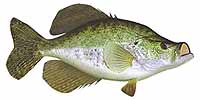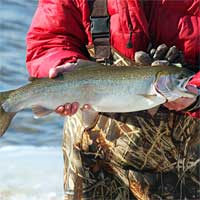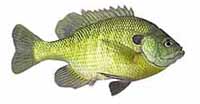Fishing Report For Navajo Lake
AKA: Navajo Reservoir
By Rick Seaman
Last updated on .
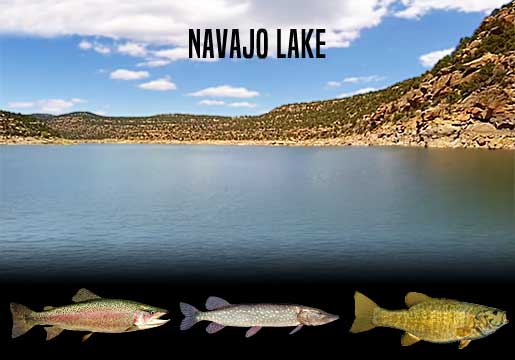
Fishing Reports
Popular Fish Species Navajo Lake, NM
Rainbow Trout
Current Report: Good
FALL. Cooling water temperatures in the shallows, draw rainbow trout out of deeper Summer depths. In addition to an on-going stocking program, the San Juan River (an excellent trout fishery) also feeds into the lake, delivering trout reportedly averaging 17" in length. The New Mexico Department of Game and Fish recommends you review the trout regulations before fishing here. Fishing reports indicate fly fishing to be very popular for avid anglers, while other anglers are catching trout on prepared baits, salmon eggs, worms and small spinners. Anglers are now catching them 10 to 25 feet deep on rocky banks, wind-blown points, rocky structure, humps, and anywhere baitfish are gathering. Now that they had a full summer to grow, there are some nice size rainbow to be caught. Small spinners, spoons, jigs, miniature crankbaits and swimbaits are good choices, as are salmon eggs and prepared baits. Later in Autumn, they move into 20 to 30 feet of water.
WINTER. When Winter sets in jigging spoons, and jigs tipped with bait, are catching nice limits of rainbows out of 20 to 35 feet of water. These baits work well before, and after, ice out. Deep trolling with leaded line or downriggers, or vertical jigging with spoons and jigs, are the best approach during the cold-water season.
SPRING. As water begins to warm in early Spring, rainbow trout move from their late winter holding areas to shallow, warmer water 5 to 20 feet deep. A good number of rainbows are typically caught from mid morning to late afternoon, during the warmest water of the day. Shallow flats and rocky structure are quick to warm in the afternoon sun. A wide variety of small spinners, spoons and bait are catching most of the fish.
SUMMER. Once Summer is here to stay, the warmer water drives rainbow deeper, 20 to 45 feet deep, occasionally deeper. Trolling with spoons, spinners and crankbaits, using downriggers or leaded line, and drift fishing with bait, are currently the most productive methods. Following drop-offs into deeper water, along structure or creek channels, is a major key to getting bites. Anglers fishing from the bank are using nightcrawlers or Berkley PowerBait, with heavy weights on a Carolina rig, to get baits in deeper water.
Northern Pike
Current Report: Fair To Good
FALL. As the weather starts turning cold, water temperatures cool fastest in the shallows. This brings baitfish into shallower waters, and northerns follow along with this food source. Locals report catching big northerns on topwater, especially during the first hour of daylight, then again in the last hour. Other times, jerkbaits, spinnerbaits, crankbaits and diving lures, in bright colors are working well. Areas with concentrations of bluegill are a magnet for these aggressive, attacking predators. They hang around weedbed edges, main-lake points, reefs, and rocky shorelines to ambush prey in 5 to 15 feet of water. This is a prime feeding time as they prepare for winter. It is also a good time to catch a trophy pike.
WINTER. Northern pike remain active in Winter, often congregating in or near remaining weed beds, especially along the edges. Additional structure options include points, reefs, ledge drop-offs, and rocky humps, preferably nearby deeper water. Comfortable depths range from 15 to 35 feet. Live bait, cut bait, Johnson spoons, big spinners and spinnerbaits all attract bites from hungry northerns.
SPRING. After any ice melts, northern pike migrate to shallow, warmer pockets, bays and coves. Once water temperatures reach around 40 degrees, they move into even shallower areas with vegetation, to spawn. Ideal depths range from 15 to 35 feet. After spawning they linger in the shallow bays for a short period. Once water temperatures rise into the 50's, they move to deeper weedbeds and shallow structures adjacent to even deeper water. Bright colors, whites and flashy lures appeal to these predators. Noisy topwater lures can also produce some spectacular strikes. Alternate between baits until you identify which one triggers the most bites for the day.
SUMMER. Northern pike scatter all around the lake, rather than gather in groups. This makes them difficult to locate. During the day they are holding from 10 to 25 feet deep, on ledges, reefs, weedbeds, rock piles, islands and channel edges. Some of the larger specimens are suspending in open water, just outside feeding areas. Trolling or drift fishing produces some nice catches, using spoons, big spinners, cut bait, and deep diving crankbaits. Early and late in the day, they move shallow to feed and can be caught around most weedy shorelines, in 5 to 12 feet of water. Noisy topwater lures, spinnerbaits and Johnson spoons with curly-tail grubs, are catching nice pike shallow.
Smallmouth Bass
Current Report: Fair To Good
FALL. As Fall arrives, smallmouth here follow schools of baitfish into coves and bays 5 to 20 feet deep. Smallies are being caught early and late in the day. Main-lake rocky shorelines are a good place to start, using topwater lures. They thrive in the cold, clean water, which is an ideal environment for them. Locals report that tube jigs are a great choice when the bass are in 15' or shallower. Drop shot rigs with small worms or shad shaped plastics are also popular in 10' water or deeper. Jerkbaits, deep-diving crankbaits, and slow-rolled spinnerbaits, are also successful, when bass are shallow to mid depth. Later in Fall, smallies move to slightly deeper water, around 10 to 20 feet deep. Fishing shallow for smallmouth is often good on cold, windy, cloudy and rainy days.
WINTER. Winter will isolate them around deeper structure, points, flats and creek channels, often suspending in open water above these features. They can generally be found from 20 to 40 feet deep. Jigging spoons, tube baits, drop-shot worms, jigs and Ned rigs tend to temp smallmouth in deep water. I like to work these deeper haunts very slowly, as the bass are somewhat sluggish. Here they hold, feeding less frequently, awaiting warmer water to return in Spring.
SPRING. After ice out, if any, when water temperatures rise into the 50's, smallmouth move from deep wintering spots to shallower water, just outside spawning areas. They feed heavily in 3 to 15 feet of water at this time, and are typically caught on jerkbaits, crankbaits, tube baits, Ned rigs, and crayfish imitating plastics. Once water warms into the high 50's, they move into shallower water, and create nests in gravel or sand areas, then lay their eggs. Females then move to deeper water and males remain to guard the eggs, and then the fry. After a couple weeks, the males also move into 10 to 15 feet deep, and feed aggressively. Crankbaits, tube baits, Ned rigs, plastic worms, spoons and swimbaits are catching smallies during this period.
SUMMER. Smallmouth bass are currently feeding shallow early and late in the day in 5 to 15 feet of water. They are typically caught on topwater, crankbaits, swimbaits, Ned rigs and tube baits. Smallmouth bass here feed on crawfish, gizzard shad, and small sunfish. They prefer rocky or gravel bottom areas, as this is where crayfish live. During the hotter parts of the day, they are being caught on points, humps, and ledges around 20 to 30 feet deep. Often these deeper fish are part of a large school of smallmouth.
Fishing Video
Fish species to fish for...
Guide to fishing for largemouth bass, smallmouth bass, channel catfish, black crappie, white crappie, rainbow trout, brown trout, bluegill, kokanee salmon and northern pike at Navajo Lake in New Mexico.
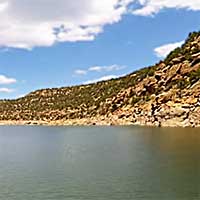 A paradise for fishing, Navajo Lake is a 15,000-acre lake on the northern border of the state. It is the second largest lake in the state with over 150 miles of shoreline. The lake offers both warm-water and cold-water fish species like rainbow trout, northern pike and smallmouth bass. Recent reports indicate good fishing for all three.
A paradise for fishing, Navajo Lake is a 15,000-acre lake on the northern border of the state. It is the second largest lake in the state with over 150 miles of shoreline. The lake offers both warm-water and cold-water fish species like rainbow trout, northern pike and smallmouth bass. Recent reports indicate good fishing for all three.
Primary fish species to catch
Click images for fishing tips and details about each species.
Today's Weather & Forecast
Fishing Boat Rentals
Click here for fishing boat rentals.
Public Boat Launch Ramps & Landings
Click here for boat ramps.
Marinas
Click here for marinas.
Fishing License
Click here for a New Mexico Fishing License.
Map - Fishing & Access
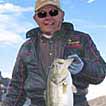 Rick Seaman is a fishing enthusiast with over five decades of fishing experience, a retired tournament fisherman, author of numerous published articles on fishing, and co-author of the book "Bass Fishing - It's not WHAT you throw, It's WHERE you throw it".
Rick Seaman is a fishing enthusiast with over five decades of fishing experience, a retired tournament fisherman, author of numerous published articles on fishing, and co-author of the book "Bass Fishing - It's not WHAT you throw, It's WHERE you throw it".
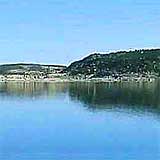 Contact Information
Contact Information
Navajo Lake State Park
36 Road 4110
Navajo Dam, NM 87419
505 632-2278
Fishing lakes in each state
101325
Navajo Lake, New Mexico Report
NEW MEXICO


Information about fishing lakes in New Mexico
Navajo Lake offers bass, catfish, crappie, trout, bluegill, kokanee salmon and northern pike fishing in northern NM.


